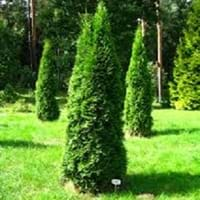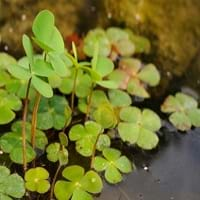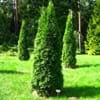Life Span
Perennial
Perennial
Type
Needled or Scaled Evergreen
Aquatics
Origin
North America, Canada
Australia
Types
Not Available
Marsilea quadrifolia, Marsilea hirsuta
Habitat
Forest edges, Hardwood forests, Hillside, Roadsides, Woods
Bog Garden, Cultivated Beds
USDA Hardiness Zone
2-7
9-11
Sunset Zone
A2, A3, H1, H2, 1a, 1b, 2a, 2b, 3a, 3b, 4, 5, 6, 7, 8, 9, 15, 16, 17, 21, 22, 23, 24
21,22
Habit
Cushion/Mound-forming
Mat-forming
Flower Color
Brown
Not Available
Flower Color Modifier
Bicolor
Not Available
Fruit Color
Light brown
Non Fruiting Plant
Leaf Color in Spring
Green
Green, Light Green
Leaf Color in Summer
Green
Green, Light Green
Leaf Color in Fall
Green
Green
Leaf Color in Winter
Green
Green
Leaf Shape
Scale-like imbricate
Four wedge-shaped leaflets
Plant Season
Spring, Summer, Fall, Winter
Spring, Summer, Fall, Winter
Sunlight
Full Sun
Full Sun, Partial Sun
Type of Soil
Clay, Loam, Sand
Loam, Sand
The pH of Soil
Acidic, Neutral
Acidic, Neutral
Soil Drainage
Average
Poorly Drained
Bloom Time
Early Spring, Late Spring
Not Available
Tolerances
Drought
Wet Site
Where to Plant?
Ground
Container, Ground, Pot
How to Plant?
Seedlings, Transplanting
Spores
Plant Maintenance
Medium
Medium
Watering Requirements
Requires watering in the growing season, Water Deeply, Water twice a day in the initial period
Needs very little water
In Summer
Lots of watering
Lots of watering
In Spring
Moderate
Moderate
In Winter
Average Water
Average Water
Soil pH
Acidic, Neutral
Acidic, Neutral
Soil Type
Clay, Loam, Sand
Loam, Sand
Soil Drainage Capacity
Average
Poorly Drained
Sun Exposure
Full Sun
Full Sun, Partial Sun
Pruning
Remove damaged leaves, Remove dead branches, Remove dead leaves
Remove damaged leaves, Remove dead branches, Remove dead leaves
Fertilizers
All-Purpose Liquid Fertilizer
Organic Manure
Pests and Diseases
Red blotch
Aphids, Clover Clot
Plant Tolerance
Drought
Drought
Flowers
Insignificant
None
Flower Petal Number
Single
Not Available
Fragrant Fruit
No
Not Available
Fragrant Bark/Stem
Yes
No
Foliage Texture
Medium
Medium
Foliage Sheen
Matte
Matte
Allergy
Asthma
Beriberi, Toxic
Aesthetic Uses
Beautification, Showy Purposes
Ground Cover
Beauty Benefits
Not Available
Not Available
Environmental Uses
Air purification
Fixes Nitrogen
Medicinal Uses
constipation, Headache
Astringent
Part of Plant Used
Whole plant
Seeds, Spores
Other Uses
Air freshner, Oil is used in perfume, soaps, creams, etc., Used as an insecticide
Used like flour, Used to make dough
Used As Indoor Plant
No
Yes
Used As Outdoor Plant
Yes
Yes
Garden Design
Edging, Foundation, Hedges, Mixed Border, Rock Garden, Wall
Container, Houseplant, Tropical, Water Gardens
Botanical Name
THUJA occidentalis 'Hetz Midget'
MARSILEA drummondii
Common Name
Northern White Cedar
Eastern Arborvitae
Common Nardoo, Pepperwort, Water Clover
In Hindi
अमेरिकी Arborvitae
Water Clover
In German
Lebensbaum
Wasser Klee
In French
Amérique Arborvitae
Eau Clover
In Spanish
Americana Arborvitae
Agua trébol
In Greek
αμερικανική Arborvitae
νερό Clover
In Portuguese
Arborvitae americano
Clover água
In Polish
Amerykański Tuja
Woda Clover
In Latin
American Arborvitae
Trifolium aqua
Phylum
Not Available
Pteridophyta
Class
Pinopsida
Filicopsida
Order
Pinales
Hydropteridales
Family
Cupressaceae
Marsileaceae
Genus
Arborvitae
Marsilea
Clade
Not Available
Not Available
Tribe
Not Available
Not Available
Subfamily
Cupressoideae
Not Available
Number of Species
Not Available
Difference Between American Arborvitae and Water Clover
If you are confused whether American Arborvitae or Water Clover are same, here are some features about those plants to help you choose better. Many people think that these two plants have the same characteristics, but one can see American Arborvitae and Water Clover Information and learn more about it. Fertilizers required for proper growth of American Arborvitae are All-Purpose Liquid Fertilizer, whereas for Water Clover fertilizers required are Organic Manure. Hence, one should know the basic difference between American Arborvitae and Water Clover if you are planning to have them in your garden to enhance its beauty.
<
Flowering PlantsImportance of American Arborvitae and Water Clover
Want to have the most appropriate plant for your garden? You might want to know the importance of American Arborvitae and Water Clover. Basically, these two plants vary in many aspects. Compare American Arborvitae and Water Clover as they differ in many characteristics such as their life, care, benefits, facts, etc. Every gardener must at least have the slightest clue about the plants he wants to plant in his garden. Compare their benefits, which differ in many ways like facts and uses. The medicinal use of American Arborvitae is constipation and Headache whereas of Water Clover is Astringent. American Arborvitae has beauty benefits as follows: Not Available while Water Clover has beauty benefits as follows: Not Available.
Compare Facts of American Arborvitae vs Water Clover
How to choose the best garden plant for your garden depending upon its facts? Here garden plant comparison will help you to solve this query. Compare the facts of American Arborvitae vs Water Clover and know which one to choose. As garden plants have benefits and other uses, allergy is also a major drawback of plants for some people. Allergic reactions of American Arborvitae are Asthma whereas of Water Clover have Beriberi and Toxic respectively. Having a fruit bearing plant in your garden can be a plus point of your garden. American Arborvitae has no showy fruits and Water Clover has no showy fruits. Also American Arborvitae is not flowering and Water Clover is not flowering . You can compare American Arborvitae and Water Clover facts and facts of other plants too.





